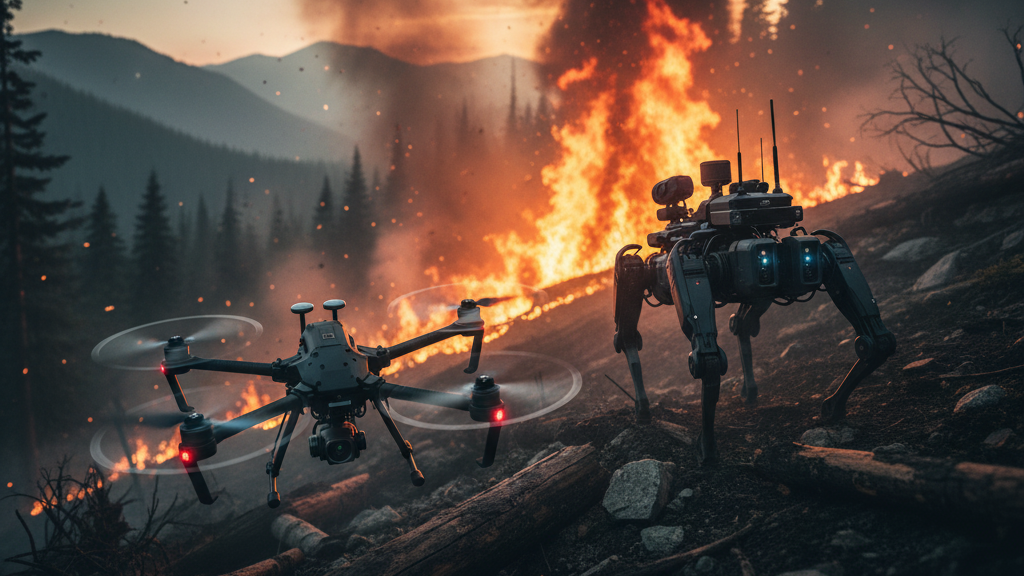
Mission Statement
Welcome to the PERception and RObotics Laboratory (PERRO) at Thompson Rivers University. Our research program is dedicated to advancing the autonomy of robotic systems by developing novel algorithms for perception, state estimation, and control. We develop capabilities for individual autonomous platforms and extend them to collaborative teams of aerial and legged robots. A primary goal of our work is to address the pressing challenges of wildfire management by developing new robotic capabilities for tasks such as mapping fire zones, assessing damage, and analyzing regrowth patterns.
Research Themes
Multi-Robot Perception and State Estimation
We develop robust perception systems to accurately estimate a robot’s position and velocity in challenging settings. Our work fuses data from visual, inertial, thermal, and lidar sensors to enable navigation in dynamic environments where traditional methods may fail, such as in the presence of smoke.
Adaptive Locomotion for Legged Robots
This research enables legged robots to traverse difficult and varied terrain, including the soft or deformable surfaces common in post-fire landscapes. We build on our previous work, such as the STANCE algorithm for soft terrain adaptation, to create controllers that allow robots to adapt to terrain in real-time.
Collaborative Autonomy for Aerial-Ground Teams
We create control strategies for teams of quadrotor drones and quadruped robots to work together on complex tasks. ]This involves developing algorithms for coordinated control, mapping, and state estimation, allowing the team to leverage the unique perspectives and complementary strengths of both ground and aerial platforms.
Robotics Software Engineering
We build the sophisticated, real-time software frameworks that run our perception and control systems. Our work focuses on creating novel software architectures that are modular and generic, capable of supporting different types of walking robots
Lab Highlights
Lab Receives Major Equipment Grant from CFI JELF
In October 2025, our lab was awarded a grant from the Canada Foundation for Innovation’s (CFI) John R. Evans Leaders Fund (JELF). This is the lab’s first major equipment funding, and it will significantly expand our research capabilities by providing a new quadruped robot, an aerial drone, and high-performance computing resources for our wildfire management research.
Dr. Fink Promoted to Associate Professor
In Summer 2025, Dr. Fink was promoted to the rank of Associate Professor at Thompson Rivers University. This promotion recognizes his significant and sustained contributions to research, teaching, and service, and reflects the success of the lab’s research program.
New Research Published in IEEE Robotics and Automation Letters
In 2025, the lab published two new journal articles in the prestigious IEEE Robotics and Automation Letters. The papers introduce novel methods for multi-sensor state estimation for quadruped robots, including a real-time estimator named MUSE.
Congratulations Dr. Ylenia Nisticò!
We congratulate Ylenia Nisticò on successfully defending her PhD thesis, "Enhancing State Estimation in Quadruped Robots: Multi-Sensor Fusion for Challenging Terrains," in 2025. Dr. Nisticò completed her PhD at the Università di Genova under the supervision of Dr. Fink.
Dr. Fink Receives TRU Early Career Award of Excellence
In 2024, Dr. Fink received the Early Career Faculty of Science Award of Excellence at TRU. This prestigious award recognizes his outstanding contributions to teaching, research, and service.
Prestigious NSERC Discovery Grant Awarded
Our lab’s long-term research program is supported by an NSERC Discovery Grant (2023-2028). This highly competitive national grant funds our foundational research into robot perception, state estimation, and control.
Research Applications
Wildfire Management:
In Our primary application is developing robotic systems to enhance safety and efficiency in wildfire management. We are creating collaborative drone and legged-robot teams for tasks spanning the full event lifecycle, from risk assessment and real-time fire monitoring to post-fire damage analysis and regrowth mapping
Exploration & Mapping in GPS-Denied Environments
We develop novel Simultaneous Localization and Mapping (SLAM) algorithms that enable single robots or multi-robot teams to explore and create maps of complex, unstructured environments where GPS is unavailable.
Disaster Response & Search and Rescue
Our research on multi-robot collaboration is directly applicable to disaster response, where drones provide aerial situational awareness to guide legged robots on the ground. This synergy allows teams to navigate rubble and enter collapsed structures to locate survivors in environments too dangerous for humans.
Autonomous Inspection & Maintenance
We use dynamic visual servoing to enable robots to perform precise inspection and maintenance tasks. This allows a robot to autonomously navigate to and hold its position relative to a specific visual feature—such as a weld, crack, or valve—on infrastructure like bridges, pipelines, and industrial machinery.